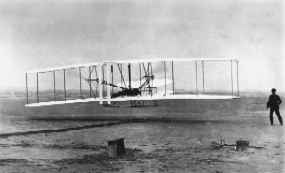1903-The First Flight
December 17, 1903
The 27-mph wind was harder than they would have liked, since their predicted cruising speed was only 30-35 mph. The headwind would slow their groundspeed to a crawl, but they proceeded anyway. With a sheet, they signaled the volunteers from the nearby lifesaving station that they were about to try again. Now it was Orville's turn.
The 27-mph wind was harder than they would have liked, since their predicted cruising speed was only 30-35 mph. The headwind would slow their groundspeed to a crawl, but they proceeded anyway. With a sheet, they signaled the volunteers from the nearby lifesaving station that they were about to try again. Now it was Orville's turn.
Remembering Wilbur's experience, he positioned himself and tested the controls. The stick that moved the horizontal elevator controlled climb and descent. The cradle that he swung with his hips warped the wings and swung the vertical tails, which in combination turned the machine. A lever controlled the gas flow and airspeed recorder. The controls were simple and few, but Orville knew it would take all his finesse to handle the new and heavier aircraft.

Orville takes off with Wilbur running beside, December 17, 1903.
NPS
At 10:35, he released the restraining wire. The flyer moved down the rail as Wilbur steadied the wings. Just as Orville left the ground, John Daniels from the lifesaving station snapped the shutter on a preset camera, capturing the historic image of the airborne aircraft with Wilbur running alongside. Again, the flyer was unruly, pitching up and down as Orville overcompensated with the controls. But he kept it aloft until it hit the sand about 120 feet from the rail. Into the 27-mph wind, the groundspeed had been 6.8 mph, for a total airspeed of 34 mph. The brothers took turns flying three more times that day, getting a feel for the controls and increasing their distance with each flight. Wilbur's second flight - the fourth and last of the day – was an impressive 852 feet in 59 seconds.
Although the town of Kitty Hawk is always associated with the exploits of the Wright brothers, most of their flying experiments took place about 4 miles to the south on the sands of Kill Devil Hills.
 In 1902, the Wrights made 250 glides in just two days and tallied more than 1,000 glides in one month. From the hills, they perfected the art of soaring and control of the aircraft.
In 1902, the Wrights made 250 glides in just two days and tallied more than 1,000 glides in one month. From the hills, they perfected the art of soaring and control of the aircraft. Neil Armstrong, the first man to step foot on the moon, carried with him a piece of the cloth and wood from the original 1903 Wright Flyer.
Neil Armstrong, the first man to step foot on the moon, carried with him a piece of the cloth and wood from the original 1903 Wright Flyer.

No comments:
Post a Comment